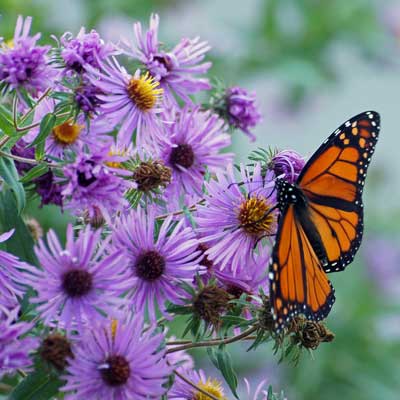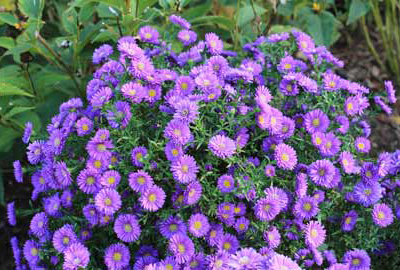 Monarch butterfly on Aster
Monarch butterfly on Aster
© Thinkstock
Butterflies and other pollinators need food to the end of the season, which is why it’s important for them – and color-seeking gardeners – to have plants that bloom in fall. While the majority of flowers put on their shows in spring or summer, asters are pollinator-friendly stars of late summer to mid-fall. These cold-hardy perennials with the starry, daisy-like flowers bloom primarily in purple, lavender, and blue-purple, although they come in white and pink as well. Some, such as alpine asters (Aster alpinus), are as short as 8 inches, but most grow in the 2 to 3 foot range, up to as tall as the 6 foot tatarian aster (Aster tataricus). Many asters sold in garden centers are U.S. natives, including New England, New York, smooth, calico, heath and wood types - and technically not asters anymore, as most have been botanically renamed to the Symphyotrichum species.
 Magic Purple Aster
Magic Purple Aster
© G. Weigel
How to grow asters
Asters generally do best in full sun and damp soil, although they’re not as picky about lousy soil and summer heat as some plants. Native wood asters even do fine in the dry shade of a tree grove or forest. Asters are best fertilized and planted in spring, which is the same time to divide existing ones that are outgrowing their space or blooming poorly. We recommend a fertilizer rich in natural and organic nutrients. A small amount in the hole when planting gets newly divided plant off to a great start. To divide, dig the entire root clump and slice off fist-sized pieces from around the perimeter. Plant those, and discard the oldest section in the middle. After frost browns the foliage in fall, cut plants to a short stub.
“De-flop” your plants
Not a fan of flopping asters? You can avoid this by picking a compact variety in the first place, such as ‘Professor Kippenberg,’ ‘Sapphire,’ Magic Purple™, and the Kickin’™ series, or by using the cutback trick. Around the end of May, shear asters back by one-third to one-half. They’ll look chopped and will bloom a little later, but the flower show will be denser and compact.